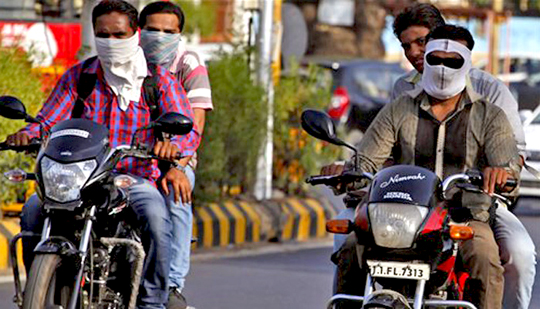New Delhi, May 31: The current heatwave gripping India is the fifth deadliest ever in the world, as per a report in a leading Daily.
Also, it is the second deadliest in India, the Daily said, quoting an international database of disasters.
Before this the worst was in 1998 when 2,541 people had died due to the heatwave.
As far as the world is concerned, the worst was the one in Europe in 2003 which had left 71,310 people dead.
Moreover, the report said that in the list of top ten worst disasters, Indian heatwaves figure four times - 1998, 2002, 2003 and 2015.
The above figures are said to be maintained in the Emergency Events Database (EM-DAT) maintained by the Centre for Research on the Epidemiology of Disasters (CRED) based in Brussels.
CRED of the Université catholique de Louvain since 1988has been maintaining an Emergency Events Database EM-DAT which was created with the initial support of the WHO and the Belgian Government.
According to the National Disaster Management Authority's website “A heatwave is a period of abnormally high temperatures, more than the normal maximum temperature that occurs during the summer season in the North-Western parts of India. Heat Waves typically occur between March and June, and in some rare cases even extend till July. The extreme temperatures and resultant atmospheric conditions adversely affect people living in these regions as they cause physiological stress, sometimes resulting in death.”
Meanwhile, The death toll in the sizzling heat wave sweeping many parts of the country on Saturday rose to 2207, with 202 more deaths being reported since yesterday from Andhra Pradesh, Telangana and Odisha.
The overall toll in various parts of the country yesterday stood at 2005.
The heat wave was witnessed in many parts of the country but Nagpur in Maharashtra recorded the highest temperature of 47.1 degrees celsius.
Andhra Pradesh reported 146 more deaths today, raising the toll 1636 since yesterday.
Prakasam district has recorded the maximum number of 333 deaths, followed by Guntur district (233), followed by East Godavari (192), Visakhapatnam (185), Vizianagaram (177), Nellore (163), Krishna (78), Chittoor (64), Srikakulam (60), Anantapur (56), Kadapa (38), Kurnool (34) and West Godavari (23).
According to the MeT department, heat wave conditions prevailed today over some parts in the districts of Guntur and Kurnool of Rayalaseema. The highest maximum temperature of 47 deg Celsius was recorded at Jangamaheshwarapur, as per PTI.
Rain occurred at a few places over Rayalaseema and at isolated places over Coastal Andhra Pradesh.
In Telangana, the toll due to the heat wave rose to 541 today, with 52 more deaths being reported during the last 24 hours, said a senior official of the state disaster management department. The toll in the state was 489 yesterday.
The toll in Odisha also rose to 21 from 17 since yesterday. Seven deaths have so far been reported from Gujarat and two from Delhi.
Since April 15, Nalgonda district in Telangana has recorded maximum number of 139 deaths, followed by Karimnagar (120), Khammam (95) and Mahabubnagar (42).
Heat wave has claimed 36 lives in Ranga Reddy district followed by 35 in Medak district, 26 in Adilabad, 20 in Warangal, 18 in Nizamabad, and 10 in Hyderabad.
The highest maximum temperature of 47 degree Celsius was recorded at Ramagundam yesterday.
According to met department, isolated rain occurred over Telangana yesterday.
In Odisha, the Special Relief Commissioner's (SRC) office received reports of 108 deaths allegedly due to sun stroke. However, only 21 have been confirmed as death due to heat stroke.






Comments
Add new comment